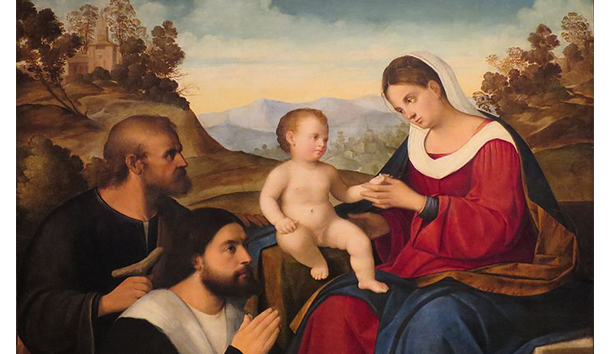“If you’ve got a business—you didn’t build that,” President Obama declared in 2012. But chances are you bought that, especially if you are a Midwestern entrepreneur and the product is Renaissance art. The coastal stereotype of the Midwest as a cultural backwater is dispelled by museums in industrial towns like Detroit, Toledo, and Dayton. Here, artistic relevance is measured in terms of half a millennium, not Andy Warhol’s 15 minutes.
We’ve traveled hundreds of miles to view The Holy Family With a Donor in a Landscape, by Pier Francesco Bissolo (1470-1554), a Renaissance oil on wood panel ensconced at the Dayton Art Institute. My first visit to Dayton, in the mid-1970’s, elicited thoughts of industrialist Walter Chrysler. The blue-and-white Chrysler Pentastar logo atop the Airtemp Division was visible from I-75, though there was no marker explaining Dayton’s relationship with the Manhattan skyscraper that Chrysler built for his children. Chrysler became interested in air conditioning while his namesake skyscraper was being built (1928-30). Airtemp moved to a revamped Dayton Maxwell plant in 1936, and, as a history of Chrysler declares, “quickly became an engineering leader in this newly emerging industry.” In 1937, Airtemp’s engineers “invented capacity regulators, which helped the air-conditioning system adjust to varying loads, and the following year they developed the first self-contained air conditioning units.” Air conditioning was “a novel product in the 1930s,” so Airtemp “had to convince potential buyers that they needed air conditioning in the first place.” Dayton was the site they chose, though this history is unrecognized in art. A healthier American culture might produce an oil portrait of Chrysler the patriarch contemplating this modern convenience, set against the backdrop of his factory in southwestern Ohio.
Painted in Florence under Medici patronage, Bissolo’s Holy Family was, at the time of its acquisition, the Dayton Art Institute’s most expensive work. It was acquired from a British collection with funds provided by the families of John Berry and James F. Dicke. Both were Ohio businessmen. Dayton’s catalogue notes that the museum was “quite lucky to be able to acquire it because this kind of work, being in private hands for this long, is highly unusual.”
The anonymous donor is important to the painting. As Dayton’s catalogue explains,
You can feel the emotion, especially of the patron who sits with his hands clasped in a manner of prayer, looking at the baby Jesus and his mother, and thinking thoughts that a patron obviously should be thinking.
A virtuous cycle of giving is revealed as one contemplates the work. The anonymous donor commissioned the work nearly five centuries ago. A British patron of the arts later purchased it. Modern donors brought it to the industrial Midwest. Perhaps a future donor, inspired by the work’s presence in Dayton, will engage in further generous acts of giving.
Bissolo studied under the Venetian painter Giovanni Bellini, who also taught Titian. The Detroit Institute of Arts, where my aunt, Annie Lazurek, oftentimes took me as a youth, is known worldwide for Diego Rivera’s Detroit Industry Murals, which depict Ford Motor Company’s sprawling River Rouge Plant. Edsel Ford, son of Henry Ford, helped fund the project at the height of the Great Depression. The DIA is also home to Bellini’s Madonna and Child, Sandro Botticelli’s The Resurrected Christ, and numerous works of Renaissance art. The purchase of many, including Piazzetta’s Madonna and Child With Adoring Figure, Perugino’s Madonna and Child, and Veronese’s The Mystic Marriage of St. Catherine, were funded by the automotive entrepreneurs and their families. The same is true down I-75 in Toledo. Edward Drummond Libbey was the founder of Toledo’s world-famous glass industry and its Museum of Art, home to Orthodox icons dating to the 14th century; the School of Andrey Rublyov’s Dormition of the Virgin; Francisco Pesellino’s Madonna and Child With Saint John; Piero di Cosimo’s The Adoration of the Child; and Jacobello del Fiore’s The Crucifixion. Dayton’s Holy Family is but one example of an artistic commitment evident in the cultural institutions of the industrial Midwest.
Whether High Renaissance or post-Christian American, culture gives rise to man’s conception of himself. That is why the substance of our culture, and what that culture values, matters. Christian art is eternal; post-Christian culture, fleeting. Even as it ushered in the modern era, the Renaissance maintained Christ in a prominent position, while, in post-Christian American culture, there is no room at the inn. Renaissance patrons like the donor are often depicted in earnest prayer, begging salvation for self and family. Their modern counterparts are more likely to highlight a tattoo as they take a selfie.

Leave a Reply